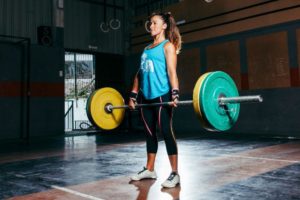The deadlift is a fundamental exercise targeting multiple muscle groups, making it popular for strength training enthusiasts.

Whether you’re a seasoned lifter or just starting, evaluating your individual fitness goals and abilities is essential. It determines if it is good for you.
In this article, we will delve into the 315-pound deadlift. Let’s explore whether it is a suitable milestone for your fitness journey.
We will provide you with the knowledge you need to understand it better and help you make an informed decision.
However, you must remember everyone’s fitness journey is unique, so you must focus on your progress rather than comparing yourself to others.
Understanding Deadlift Standards
Before determining if a 315-pound deadlift is good for you, you must understand its standard and benchmarks.
Strength standards will provide a framework for assessing one’s strength level and serve as reference points for progress.
These standards are based on gender, body weight, and experience level.
What Are Strength Standards and Benchmarks?
Strength standards are guidelines classifying different strength levels based on specific performance criteria.
It provides ways to compare an individual’s strength against established standards within the fitness community.
In contrast, benchmarks represent specific weight milestones commonly recognized as significant achievements in strength training.
Factors Influencing an Individual’s Deadlift Performance:
Several factors come into play when considering an individual’s deadlift performance.
- Training experience: Novices have lower strength levels than experienced lifters.
- Muscle mass and body composition: More muscle mass and lower body fat enhance deadlift performance.
- Technique and form: Proper technique reduces injury risk and optimizes deadlift performance.
- Leverages and body proportions: Body proportions and limb lengths impact biomechanics during the deadlift.
Assessing Individual Fitness Level
Assess your fitness level to determine if a 315-pound deadlift suits you. Here’s how you assess it:
The Importance of Proper Form and Technique

Before lifting weights, you must prioritize proper form and technique during the deadlift.
Maintain a neutral spine, engage the appropriate muscles, and execute the movements with control.
It is essential to maximize the performance and reduce the risk of injury. Focus on mastering fundamentals and seek guidance from a qualified professional if needed.
Evaluating Current Deadlift Performance
Assess your current deadlift performance to understand your strength level. Consider the weight you can lift currently with proper form and technique.
Self-evaluation helps you identify areas for improvement and track your progress over time.
Determining the Individual’s Training Experience and Overall Strength
Consider your training experience and overall strength when evaluating the suitability of a 315-pound deadlift.
If you are a novice lifter, you should focus on building a foundation of strength. Also, perfect the technique before attempting heavier weights.
In contrast, individuals with more training experience and developed strength are better equipped to handle the load.
Evaluating Strength and Fitness Goals
Evaluate your strength and fitness goals to determine if a 315-pound deadlift suits you.
Understand different types of fitness goals, setting realistic and achievable objectives if it aligns with your aspiration.
Identifying Different Fitness Goals
Fitness goals vary widely among individuals, from general fitness to strength training or powerlifting.
Identify your primary fitness goals, as it provides clarity and allows you to tailor your training accordingly.
Discussing the Significance of Setting Realistic and Achievable Goals
Set realistic and achievable goals to maintain your motivation and track progress.
Consider your fitness level, training experience, and the time and effort you can commit.
Setting goals will create a roadmap for success and avoid injury or frustration.
Analyzing How a 315-Pound Deadlift Aligns with Your Goals

Analyze how a 315-pound deadlift aligns with your aspirations. Consider whether this weight milestone is relevant to your goals.
If your focus is general fitness, a 315-pound deadlift may not be necessary.
However, if you aim to build strength or compete in powerlifting, reaching and surpassing a 315-pound deadlift could be significant.
Considering Body Weight and Size
Consider body weight and size when evaluating the suitability of a 315-pound deadlift.
These factors significantly influence deadlift performance and determine if lifting that weight is appropriate.
The Influence of Body Weight and Size on Deadlift Performance
Body weight and size impact deadlift performance. More muscle mass and strength relative to body weight can provide an advantage for lifting heavier weights.
However, strength isn’t solely determined by body weight alone, as factors like muscle distribution, body composition, and biomechanics also matter.
Relative Strength and How It Applies to Deadlifts
Relative strength compares an individual’s strength to body weight, enabling fair comparisons across different weights.
It’s crucial when evaluating deadlift performance, providing a more accurate measure of strength relative to body weight.
Evaluating the Appropriateness of a 315-Pound Deadlift Based on Body Weight
Evaluate the appropriateness of a 315-pound deadlift based on body weight by considering relative strength standards.
Higher body-weight individuals may achieve a 315-pound deadlift within the expected range, while lower body-weight individuals may think it exceptional.
Progression and Training Considerations
Consider progression and training strategies when assessing the suitability of a 315-pound deadlift.
The Importance of Progressive Overload in Strength Training
Progressive overload is vital in strength training.
Gradually increase the weight, volume, or intensity of your deadlift training to challenge your muscles and promote growth.
Outline Different Training Strategies for Deadlift Progression
There are various strategies you can employ to progress in your deadlift training.
- Incremental weight increases: Gradually add weight to the bar in small increments for progressive overload.
- Repetition and set adjustments: Increase reps or sets in deadlift sessions to boost volume and stimulate muscle growth.
- Variation and accessory exercises: Include deadlift variations or accessory exercises targeting specific muscle groups.
- Periodization: Structure your training into phases (e.g., strength, hypertrophy, peaking) for optimized progress and avoiding plateaus.
Provide Recommendations Based on the Individual’s Current Deadlift Performance
- Refine form and technique: Perfect deadlift form for efficiency and injury prevention.
- Gradual weight increases: Add weight gradually, considering strength level and maintaining proper form.
- Progress volume and intensity: Increase sets, reps, or intensity progressively in deadlift sessions.
- Listen to your body: Pay attention to fatigue, recovery, and well-being to avoid overtraining and sustain progress.
Potential Risks and Injury Prevention
Prioritize injury prevention when assessing the suitability of a 315-pound deadlift. Deadlifting carries risks and stress on the body.
Minimize injuries by understanding common risks, implementing warm-up techniques, emphasizing form and safety precautions, and listening to your body.
Common Risks Associated with Deadlifting:
- Lower back strain or injury: Improper form, excessive weight, or lack of core engagement can strain the lower back muscles or cause herniated discs.
- Muscle strains and tears: Inadequate warm-up, poor technique, or overexertion can result in muscle strains or tears, particularly in the hamstrings, glutes, or quadriceps.
- Grip and forearm injuries: Holding heavy weights can stress the grip and forearm muscles, potentially causing strains or tears.
Proper Warm-Up, Form, and Safety Precautions:
- Warm-up: Perform a dynamic warm-up with mobility exercises, light cardio, and specific warm-up sets to prepare for deadlifting.
- Form and technique: Maintain a neutral spine, brace the core, and use proper lifting mechanics. Seek guidance if needed.
- Gradual progression: Increase weight gradually while maintaining control, form, and confidence.
- Safety equipment: Consider weightlifting belts, straps, or chalk for improved grip and support.
Injury Prevention
Injury prevention is crucial for long-term success and enjoyment in strength training.
- Recovery and rest: Prioritize rest and recovery between sessions to prevent overtraining and promote muscle repair.
- Cross-training and mobility: Include exercises and stretches that enhance mobility, stability, and muscular balance.
- Listen to your body: Avoid pain, discomfort, and fatigue. Modify your approach or seek professional guidance if needed.
Conclusion
Determining whether a 315-pound deadlift is good for you requires a holistic approach.
By carefully considering all the discussed factors, you can make an informed decision that aligns with your goals, abilities, and overall well-being.
Remember to approach your deadlift journey with patience, dedication, and a focus on consistent progress.
Whether you reach the 315-pound milestone or surpass it, the most critical aspect is prioritizing safety.
Enjoy the process, and strive for personal growth in your strength training endeavors.

Some people collect expensive old cars, and I’m into collecting bikes. I have 15 different bikes: special mountain bikes, sportbikes, professional, amateur, and city bikes. My friends and colleagues call me a ‘bike expert’ because I give advice on how to choose the right bike.
I’m also a massive fan of gym culture and heavyweight workouts. I met Alan at my local gym, and we’ve become friends quite soon. His idea of starting a sports blog seemed interesting to me, so I agreed to help.





